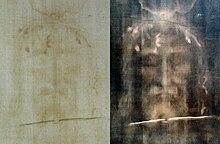Shroud of Turin
This article does not have any sources. (January 2022) |

The Shroud of Turin is a piece of cloth that bears the negative image of a man. It was first mentioned in 1354. Shortly afterwards, a Catholic bishop called it a fake. Since the 17th century, it has been kept in Turin, Italy. The shroud has the negative image of a man. Some claim the image depicts Jesus of Nazareth and the fabric is the burial shroud in which he was wrapped after his Crucifixion. In 2024 researchers at the Institute of Crystallography of the National Research Council in Italy used X-ray scattering to study the fabric.This helped them look at cellulose patterns. After comparing the cloth with other pieces of material from that century, they found the cellulose breakdown was similar. The study said: "The data profiles were fully compatible with analogous measurements obtained on a linen sample whose dating, according to historical records, is 55-74 AD, found at Masada, Israel [Herod's famous fortress built on a limestone bedrock overlooking the Dead Sea].The researchers continued: "To make the present result compatible with that of the 1988 radiocarbon test, the Shroud of Turin should have been conserved during its hypothetical seven centuries of life at a secular room temperature very close to the maximum values registered on the earth."[1]
References
[change | change source]- Shroud Turin July 24,2019
- comedy-of-errors-1988-c14-dating-of-the-shroud-of-turin02/27/2022
- new-technology-suggests-shroud-of-turin-is-2000-years-old Aleteia April 22,2022
- National Catholic Register December 30,2022
- The Catholic Weekly April 5,2023
